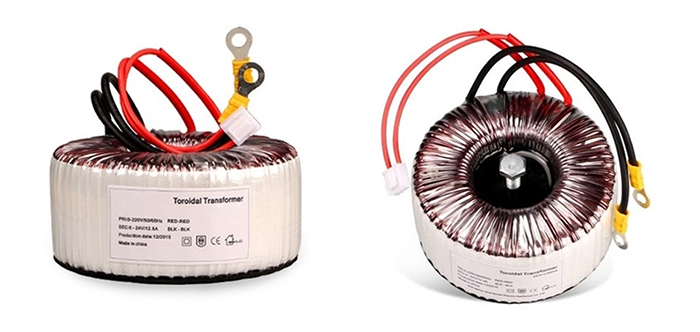FAQ - Toroidal Transformers
Can the output end of a toroidal transformer with multiple windings be loaded at the same time?
Yes. The prerequisite is that the sum of the power of the output windings of the toroidal transformer cannot be greater than the rated power of the transformer. For example, for a dual-winding toroidal transformer with a rated power of 500VA, the outputs are 12V/300VA and 24V/200VA, respectively. Both sets of outputs are loaded at the same time. The load power of 12V cannot exceed 300VA, and the load power of 24V cannot exceed 200VA, otherwise the long-term overload operation will cause the toroidal transformer to be burned out.
The vibration of the toroidal transformer is very large. What might be the cause?
- The toroidal transformer is severely overloaded.
- The input voltage exceeds the rated value by more than 10%.
- The installation and fixing of the transformer is not firm.
- There are problems with the design and production process of the transformer itself.
- The transformer cannot match the load parameters.
 What are the features of a toroidal isolation transformer?
What are the features of a toroidal isolation transformer?
- Toroidal isolation transformer is a transformer with input and output windings completely independent and isolated from each other with an insulation layer in the middle.
- Toroidal isolation transformer is mainly used in places to avoid electric shock and protect human safety.
- 220V to 220V toroidal isolation transformer is mainly used to isolate the earth.
- Toroidal isolation transformers are used in most precision instruments, medical equipment, and mines.
What is the maximum power of a 500W toroidal transformer?
Generally the toroidal transformer is marked with rated power, that is, no-load power. In general, the actual power is smaller than the no-load power. ATO toroidal transformer is wound with all copper wire, whose actual power is higher than that of the transformer with aluminum or copper-clad aluminum wire, reaching over 95%.
Under what circumstances can a toroidal transformer not be used normally?
- Toroidal transformers cannot be used normally in the case of being proved to be unqualified in production processes or tests.
- If the parameters of the toroidal transformer cannot be matched with the parameters of the paired equipment, the toroidal transformer cannot be used normally, so the customer must explain the use occasions and needed parameters with the manufacturer before purchasing the toroidal transformer.
- If the toroidal transformer is accidentally broken during logistics or courier transportation, or the base of the toroidal transformer is deformed, causing mutual collision between the transformers, or the damage of the copper wire, it can neither be used normally.
What is the difference between a switching power transformer and a toroidal transformer?
- Switching power transformers are generally used in high-frequency circuits such as switching power supplies, while toroidal transformers are generally suitable for low-frequency circuits.
- They also have both voltage conversion and isolation functions, but toroidal transformers have better stability and longer service life than switching power transformers.
- The switching power transformer has high-frequency electromagnetic interference, and the high-frequency electromagnetic interference of the toroidal transformer is zero.
- Toroidal transformers use iron cores, and switching power transformers generally use magnetic cores. The magnetic permeability of a magnetic core is not as good as that of an iron core.
- Toroidal transformers are relatively heavy and not as lightweight as switching power transformers.
What is the efficiency of a toroidal transformer? Under what conditions is the efficiency the highest?
- In the process of transmitting electrical energy, copper loss and iron loss occur inside the toroidal transformer, causing the output power to be less than the input power. The ratio of the output power P2 to the input power P1 is called the efficiency of the transformer and is expressed by η: η = P2 / P1 * 100%.
- The efficiency is highest when the toroidal transformer is operating under load and when the copper loss is equal to the iron loss.

